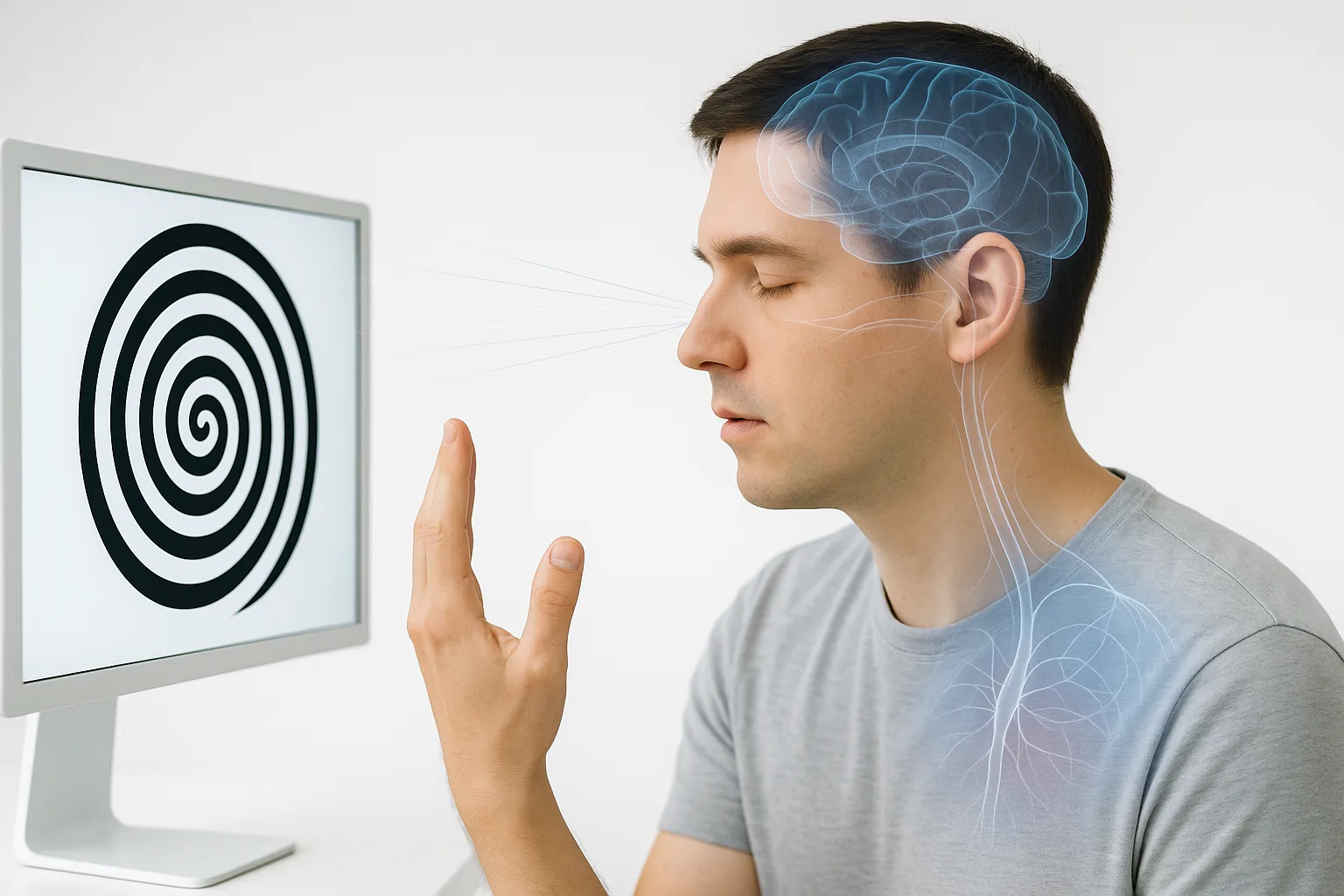Have you ever stared at a moving pattern, looked away, and suddenly everything else seemed to drift in the opposite direction? This strange experience is known as the motion aftereffect, and it is one of the most striking brain–body illusions humans can feel without equipment.
The motion aftereffect illusion test reveals how your brain processes continuous motion, how neurons adapt to repeated movement, and why your perception temporarily reverses even though nothing is actually moving.
This illusion shows that your brain does not simply report what your eyes see — it predicts, compensates and adjusts motion to maintain stability.
Let’s begin.
Step 1 — Choose a Repetitive Moving Pattern
Find or open a moving pattern, such as:
- a spinning spiral
- a waterfall video
- a rotating wheel
- scrolling text
- a moving optical illusion GIF
The stronger the motion, the clearer the effect.
Why this matters
The motion aftereffect illusion test depends entirely on motion adaptation — your motion-sensitive neurons must be stimulated long enough to fatigue.
This creates the illusion later.
Step 2 — Stare at the Moving Pattern for 20 to 30 Seconds
Fix your gaze at the center of the moving image.
Do not look around.
Do not blink excessively.
Just stare.
What’s happening now
Motion-sensitive neurons in your visual cortex are firing continuously and begin to adapt.
Your brain prepares to compensate for the perceived motion.
This sets up the illusion.
Step 3 — Immediately Look at a Still Surface
Now shift your eyes from the moving image to something still, such as:
- a wall
- your hand
- a table
- a blank screen
- a notebook
- the floor
What you’ll see
The still surface will appear to:
- drift
- move
- stretch
- sway
- ripple
- shift direction
Even though nothing is moving at all.
This is the motion aftereffect.
Step 4 — Try a Spinning Spiral for a Stronger Illusion
Repeat the test using a rotating spiral illusion.
Stare at the center.
Then look at your hand or a wall.
What changes
You’ll see the surface expand or contract depending on the spiral’s direction.
This variation produces one of the strongest versions of the motion aftereffect illusion test.

Step 5 — Try the Waterfall Illusion
Watch a waterfall, fountain, or vertical scrolling pattern for 20 to 30 seconds.
Then look at a rock, wall or static object nearby.
Result
You will see upward motion even though the surface is still.
This effect was discovered centuries ago and remains one of the most studied visual illusions.
Step 6 — Use a Sideways Motion Pattern
Try with:
- cars passing
- runners moving in one direction
- horizontal scrolling text
- conveyor belts
After staring, look at something still.
What you’ll notice
The surface now seems to move sideways in the opposite direction.
This confirms the directional adaptation of motion-sensitive neurons.
Step 7 — Repeat the Test With Faster Motion
Choose a faster-moving pattern and repeat.
Outcome
The illusion intensifies because faster motion overstimulates the motion detectors in your visual cortex.
The motion aftereffect illusion test becomes clearer with stronger stimuli.
Step 8 — Reduce the Time to 10 Seconds to Test Sensitivity
Try again but this time stare for only 10 seconds.
What changes
A shorter duration may still produce the illusion, but it will be weaker.
This shows how motion adaptation accumulates gradually.
Step 9 — Try the Test Using Only Peripheral Vision
Stare at the center of the moving pattern, but focus your attention on the edges.
Then look away.
What you’ll notice
The aftereffect appears even in your peripheral field.
This demonstrates that motion detection is widespread across the visual cortex, not just in the center.
Step 10 — What This Brain–Body Glitch Reveals About You
The motion aftereffect illusion test provides major insights into visual processing:
1. Your brain adapts to repeated motion
Motion neurons reduce sensitivity after prolonged activation.
2. Opponent-process mechanisms create the illusion
When one direction fatigues, the opposite direction temporarily dominates.
3. Vision is dynamic, not static
Your brain constantly adjusts to maintain stability.
4. You don’t see motion exactly as it is
You see motion after your brain interprets it.
5. Prediction plays a critical role
Your brain prepares for future motion, not just current motion.
6. The illusion is evidence of neural adaptation
This is one of the clearest examples of sensory adaptation in humans.
7. Perception is constructed
Your brain fills gaps when stimulus conditions change suddenly.
Understanding the motion aftereffect reveals how your brain works to create a stable and predictive visual world.
Try the Next Brain–Body Glitch Experiment
If the motion aftereffect illusion showed how your brain adapts to motion, the next experiment shows how your brain fills missing information visually. You will experience how your mind invents details that do not exist.
Next recommended experiment:
The Blind Spot Test — How Your Brain Fills Gaps in Your Vision
